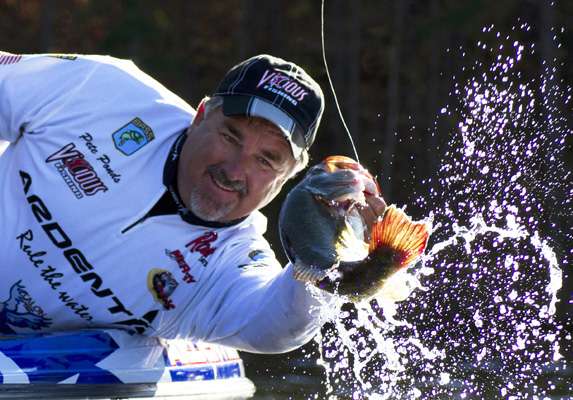
Over the years, I’ve learned that one of the most effective techniques for quality-sized winter bass (and one of the least used) is a common lipless crankbait fished faster than you might think. It’ll find them and make them bite if you throw it in the right places — even when the water temperature is in the lower 40-degree range.
When the water gets cold, the bass do not go totally lethargic and they do not stay in one place for the entire winter. They move with the weather, especially when everything warms up under a bright sun. To find these fish, you need to start looking along creek channels and in the larger sloughs.
You’re looking for flat areas alongside the channel or on the north side of the slough. The better places will be about 5 feet deep with plenty of sunshine pouring right on top of them. Deeper water will sometimes produce if the water is clear enough for the sunlight to penetrate deep. Don’t worry about structure or cover. Barren flats often out-produce those with grass, rock or wood.
Make a fairly long cast and bring your lure back with a steady, medium-speed retrieve. Think suspended bass when you’re doing this because that’s really what they’re doing. Every so often snap your rod tip up over your head as hard as you can. You want your lure to move up, and to do so fast. That’s what will usually trigger a strike, if you can call it that.
My best guess as to what’s happening is that the bass are moving up in the water column to sun themselves and take advantage of whatever warmer water they can find. They aren’t really aggressively eating; they’re just hanging out. But when the bait comes along, especially when it rapidly increases its speed, they want to swat at it. It’s their nature.
I say swat because a lot of the fish I catch doing this are hooked on the outside of the mouth. If they wanted to eat it they could. I suspect they’re reacting much like we react when a bee or a fly is buzzing around our heads. We slap at it to make it go away.
This is a technique that’s very location-specific. You might fish for an hour or more, in several places, before you catch one. But when you do, you’ll likely catch several from the same spot. Just make sure you make repeated casts to the same place and retrieve your lure at the same angle and speed.
My tackle choices are pretty straightforward. I like a 1/2-ounce Rat-L-Trap — traditional or the Pro Trap model — (color optional) thrown with a 7-3 medium-heavy action Duckett Fishing rod and a high-speed Ardent Edge reel. My line is 30-pound-test Vicious braid. I use braid because it gives me the feel I need to detect when a bass is swatting at my bait but not making contact with it.
One final tip: You don’t have to set the hook when you feel a fish. In fact, that’ll often cause you to lose it. Just loosen your drag a little and pull back hard. The hooks will penetrate past the barb and you’ll be good to go.
Don’t think your only weapon in cold water is a jig or some other slow-moving bait. Lipless crankbaits can be deadly. Give them a try.
Originally published January 2013





